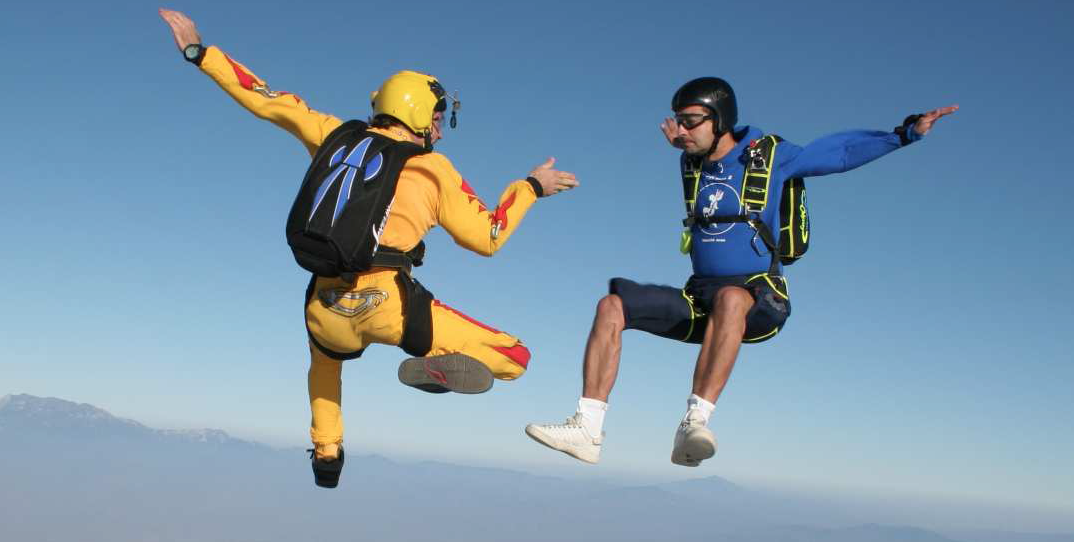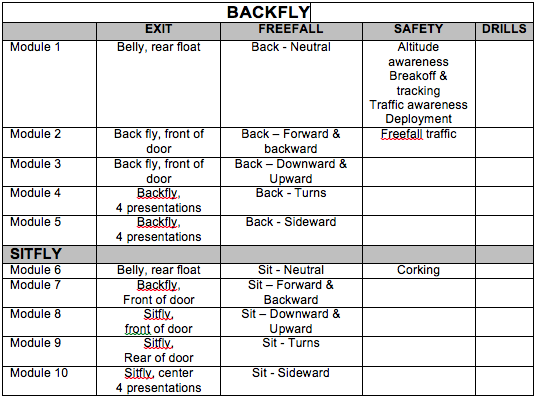Rating Certification Course
FREEFLY COACH

This Course is the first level of Freefly Coach, following the USPA/SDU Level 1 course. The Freefly course is directed towards backfly and sitfly only. The rating privileges allow the coach to perform one-on-one freefly skydiving (FF) to develop back and sitfly skills.
The first rating is a “basic freefly” coach rating, which focuses on training the fundamental skills to eventually perform group jumps safely. This course is does not include “head down” freeflying as the personal flying skills necessary must be at a much higher level; however, the course introduces additional teaching exercises, more psychological tools, and advanced skill analysis. A link to wind tunnel coaching is also included.
Skydive University offers FF Level 2 (Advanced One-on-One) for graduates of FF Level 1. This course may be taken separately or in combination with the USPA/SDU Level 1 course at an SDU Coach camp.
The course includes topics such as teaching, analyzing and psychological routines for coaching.
Prerequisites:
- Must be 18 years old
- National membership
- USPA C-license or FAI equivalent
- Have completed 200 jumps
Course Schedule
FREEFLY COACH COURSE SCHEDULE | |||||
|---|---|---|---|---|---|
| Day 1 | Module 1 | Introduction | |||
| Module 2 | The Role of the Coach | ||||
| Module 3 | Freefly matrix and progression | ||||
| Module 4 | Physiology; stretching | ||||
| Module 5 | Psychology | ||||
| Module 6 | Teaching techniques: Demonstrate Backfly Session Practice teaching |
||||
| Lunch | |||||
| Perform skills jumps applying the coach process | |||||
| Day 2 | Module 4 (Continued) | Physiology; stretching | |||
| Module 7 | Psychology | ||||
| Module 8 | Teaching techniques: Demonstrate Sitfly Session Practice teaching |
||||
| Lunch | |||||
| Module 9 | Perform skills jumps applying the coach process | ||||
| Day 3 | Evaluations | Skills jumps applying the coach process | |||
| Teaching | |||||
| Module 10 | Course Closure | ||||
Course Evaluations
Perform five (5) evaluation jumps:
Key criteria of all jumps are to achieve:
- Regain Levels and proximity
- Maintain Visual of student at all times
- Apply evasive action
- All moves are to be done to return to a certain distance to the student within a certain time (i.e. within 20 feet in 5 seconds)
Evaluation Jump # 1: Backflying skills test – Evaluator starts from a neutral set up with coach candidate, evaluator moves backward, forward, down, up and changes heading, the candidate must perform movement and return to neutral between each move. The sequence is a pre-planed sequence.
Evaluation Jump # 2: Backfly coach drill. The evaluator acts as a student with candidate leading a drill as coach. The evaluator makes errors causing changes in levels and proximity as well as heading shifts. The coach must move to keep student in visual reference at all times as well as close distances and/or apply evasive actions to avoid any potential collisions. The coach will be tested on their ability to move from belly to sit and return to belly again as needed to match fall rate changes.
Evaluation Jump # 3: Sitflying skills test – Evaluator starts from a neutral set up with coach candidate, evaluator moves backward, forward, down, up and changes heading, the candidate must perform movement and return to neutral between each move. This sequence is a Simon-Sez led by the coach in which the candidate must match the moves.
Evaluation Jump # 4: Sitfly coach drill. The evaluator acts as a student with candidate leading a drill as coach. The evaluator makes errors causing changes in levels and proximity as well as heading shifts. The coach must move to keep student in visual reference at all times as well as close distances and/or apply evasive actions to avoid any potential collisions. The coach will tested on their ability to move from sit to back and return to sit or belly as needed to match fall rate changes.
Evaluation Jump # 5: Sitfly coach drill. The evaluator acts as a student with candidate leading a drill as coach. The evaluator will create more aggressive changes in heading as well as forward or backward moves from relative to the coach causing the coach to carve, back up or need to close distance including heading shifts.
Conduct a Presentation:
Candidates will teach either Session 4 or 5 from the Basic Body Flight manual. The presentation will take approximately 45 minutes. The key issues are:
- Conduct the motor skill drills by the required repetition and holding times
- Immediately correct any student body position errors that may occur.
General Guidelines
- Avoidance - Instructor must be able to anticipate and avoid any and all movements of the student.
- Simple to complex progression.
- One step at a time, never skip a step.
- Student must complete USPA A-license requirements before beginning freefly training.
- Student’s gear must be inspected to be sure it is safe for freeflying.
- The student must have at least one audible altimeter.
- Instructor must always show confidence.
- All demonstrations should be exemplary.
- Let the student practice and hold the correct position five times with eyes open and five times with eyes closed to get the muscle memory.
- What is done on the ground will be done in the air. PRACTICING PERFECTLY MAKES PERFECT PERMANENT.
- No more than three key points for the student to focus on for any dive. This gives the student less to concentrate on and makes it easier for the instructor to focus on those key points.
- Be a role model, practice what you preach.
- Teach relative wind to the student, do non-linked exits.
FREEFLY SKILLS MATRIX


